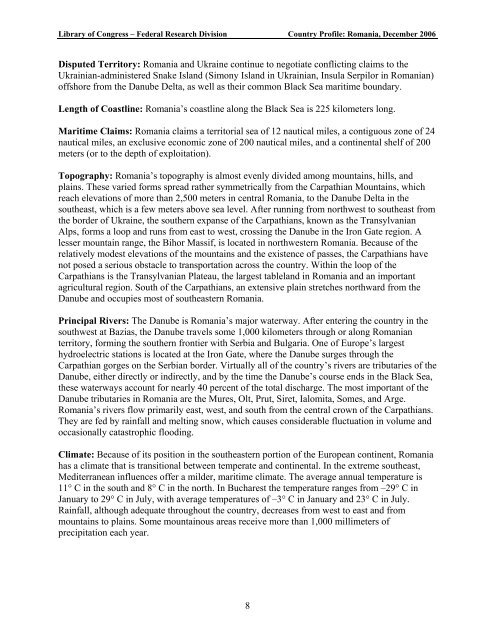Country Profile: Romania - Library of Congress
Country Profile: Romania - Library of Congress
Country Profile: Romania - Library of Congress
You also want an ePaper? Increase the reach of your titles
YUMPU automatically turns print PDFs into web optimized ePapers that Google loves.
<strong>Library</strong> <strong>of</strong> <strong>Congress</strong> – Federal Research Division <strong>Country</strong> <strong>Pr<strong>of</strong>ile</strong>: <strong>Romania</strong>, December 2006<br />
Disputed Territory: <strong>Romania</strong> and Ukraine continue to negotiate conflicting claims to the<br />
Ukrainian-administered Snake Island (Simony Island in Ukrainian, Insula Serpilor in <strong>Romania</strong>n)<br />
<strong>of</strong>fshore from the Danube Delta, as well as their common Black Sea maritime boundary.<br />
Length <strong>of</strong> Coastline: <strong>Romania</strong>’s coastline along the Black Sea is 225 kilometers long.<br />
Maritime Claims: <strong>Romania</strong> claims a territorial sea <strong>of</strong> 12 nautical miles, a contiguous zone <strong>of</strong> 24<br />
nautical miles, an exclusive economic zone <strong>of</strong> 200 nautical miles, and a continental shelf <strong>of</strong> 200<br />
meters (or to the depth <strong>of</strong> exploitation).<br />
Topography: <strong>Romania</strong>’s topography is almost evenly divided among mountains, hills, and<br />
plains. These varied forms spread rather symmetrically from the Carpathian Mountains, which<br />
reach elevations <strong>of</strong> more than 2,500 meters in central <strong>Romania</strong>, to the Danube Delta in the<br />
southeast, which is a few meters above sea level. After running from northwest to southeast from<br />
the border <strong>of</strong> Ukraine, the southern expanse <strong>of</strong> the Carpathians, known as the Transylvanian<br />
Alps, forms a loop and runs from east to west, crossing the Danube in the Iron Gate region. A<br />
lesser mountain range, the Bihor Massif, is located in northwestern <strong>Romania</strong>. Because <strong>of</strong> the<br />
relatively modest elevations <strong>of</strong> the mountains and the existence <strong>of</strong> passes, the Carpathians have<br />
not posed a serious obstacle to transportation across the country. Within the loop <strong>of</strong> the<br />
Carpathians is the Transylvanian Plateau, the largest tableland in <strong>Romania</strong> and an important<br />
agricultural region. South <strong>of</strong> the Carpathians, an extensive plain stretches northward from the<br />
Danube and occupies most <strong>of</strong> southeastern <strong>Romania</strong>.<br />
Principal Rivers: The Danube is <strong>Romania</strong>’s major waterway. After entering the country in the<br />
southwest at Bazias, the Danube travels some 1,000 kilometers through or along <strong>Romania</strong>n<br />
territory, forming the southern frontier with Serbia and Bulgaria. One <strong>of</strong> Europe’s largest<br />
hydroelectric stations is located at the Iron Gate, where the Danube surges through the<br />
Carpathian gorges on the Serbian border. Virtually all <strong>of</strong> the country’s rivers are tributaries <strong>of</strong> the<br />
Danube, either directly or indirectly, and by the time the Danube’s course ends in the Black Sea,<br />
these waterways account for nearly 40 percent <strong>of</strong> the total discharge. The most important <strong>of</strong> the<br />
Danube tributaries in <strong>Romania</strong> are the Mures, Olt, Prut, Siret, Ialomita, Somes, and Arge.<br />
<strong>Romania</strong>’s rivers flow primarily east, west, and south from the central crown <strong>of</strong> the Carpathians.<br />
They are fed by rainfall and melting snow, which causes considerable fluctuation in volume and<br />
occasionally catastrophic flooding.<br />
Climate: Because <strong>of</strong> its position in the southeastern portion <strong>of</strong> the European continent, <strong>Romania</strong><br />
has a climate that is transitional between temperate and continental. In the extreme southeast,<br />
Mediterranean influences <strong>of</strong>fer a milder, maritime climate. The average annual temperature is<br />
11° C in the south and 8° C in the north. In Bucharest the temperature ranges from –29° C in<br />
January to 29° C in July, with average temperatures <strong>of</strong> –3° C in January and 23° C in July.<br />
Rainfall, although adequate throughout the country, decreases from west to east and from<br />
mountains to plains. Some mountainous areas receive more than 1,000 millimeters <strong>of</strong><br />
precipitation each year.<br />
8

















